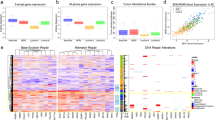Abstract
SCH58500 (ACN53) is a replication-deficient, type 5 adenovirus (Ad) expressing human wild-type p53 tumor suppressor. It is currently undergoing clinical trials as a cancer therapeutic. Many SCH58500 clinical trials incorporate an arm comparing traditional chemotherapy against chemotherapy combined with SCH58500. Paclitaxel was chosen for combination therapy in the preclinical study reported here due to its extensive use as a first-line therapy in ovarian cancer, its synergy with SCH58500 in preclinical cancer models, and its activation of p53-independent apoptosis, which might result in a “lowered threshold” for tumor cell death. SCID mice bearing human tumor xenografts were dosed with intratumoral vehicle, control Ad vector, or SCH58500, with or without paclitaxel. Real-time quantitative reverse transcriptase polymerase chain reaction assays were developed and validated to quantitate expression of p53, the p53 downstream effector gene p21, and the apoptosis-related genes, bax, bcl-2, and survivin. Protein expression was confirmed using immunohistochemical assays for p53 and p21. Only tumors injected with SCH58500 had detectable levels of exogenous p53 DNA and mRNA. After SCH58500 treatment, 3–11–fold elevations of p21 expression were observed in tumor xenografts containing nonfunctional p53 (MDA-MB-468, MDA-MB-231, MIAPaCa2, DU-145, and SK-OV-3), but no change in p21 mRNA in wild-type p53 PA-1 tumors. Immunohistochemical assays confirmed induction of p21 protein in MDA-MB-468 and SK-OV-3 cells, but not in PA-1 cells. Ad vector alone or paclitaxel alone had no effect on p21 mRNA levels in most tumors. However, paclitaxel suppressed p21 expression induced by SCH58500 4-fold in DU-145 and SK-OV-3 tumors. Paclitaxel also affected expression of the housekeeping gene gapdh. There was no consistent pattern to the changes in bax, bcl-2, or survivin after SCH58500 treatment with or without paclitaxel between tumor types, although there were consistent responses within individual tumor lines. The mRNA ratios for bax/bcl-2 and bax/survivin were also not informative across tumor types. Of the genes examined, only p21 gave a predictable response 24 hours after p53 gene therapy and therefore, p21 expression may be useful for confirming SCH58500 activity in human tumor biopsies. Cancer Gene Therapy (2000) 7, 1469–1480
This is a preview of subscription content, access via your institution
Access options
Subscribe to this journal
Receive 12 print issues and online access
$259.00 per year
only $21.58 per issue
Buy this article
- Purchase on Springer Link
- Instant access to full article PDF
Prices may be subject to local taxes which are calculated during checkout
Similar content being viewed by others
Author information
Authors and Affiliations
Corresponding author
Rights and permissions
About this article
Cite this article
Wen, S., Xie, L., McDonald, M. et al. Development and validation of sensitive assays to quantitate gene expression after p53 gene therapy and paclitaxel chemotherapy using in vivo dosing in tumor xenograft models. Cancer Gene Ther 7, 1469–1480 (2000). https://doi.org/10.1038/sj.cgt.7700257
Received:
Accepted:
Published:
Issue Date:
DOI: https://doi.org/10.1038/sj.cgt.7700257
Keywords
This article is cited by
-
Biological activities of a recombinant adenovirus p53 (SCH 58500) administered by hepatic arterial infusion in a Phase 1 colorectal cancer trial
Cancer Gene Therapy (2006)
-
Inefficient killing of quiescent human epithelial cells by replicating adenoviruses: potential implications for their use as oncolytic agents
Cancer Gene Therapy (2005)
-
Assessment of p53 gene transfer and biological activities in a clinical study of adenovirus-p53 gene therapy for recurrent ovarian cancer
Cancer Gene Therapy (2003)
-
Global transcriptional program of p53 target genes during the process of apoptosis and cell cycle progression
Oncogene (2003)
-
survivin messenger RNA expression is a good prognostic biomarker for oesophageal carcinoma
British Journal of Cancer (2002)



